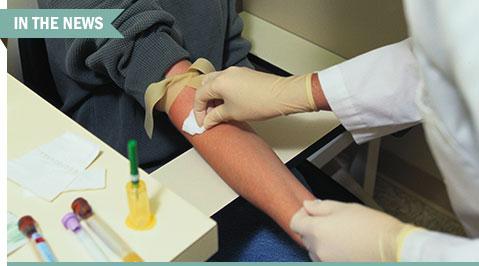
Image Credit: Keith Brofsky
Thousands of attendees at AACC’s 2015 Annual Meeting & Clinical Lab Expo in Atlanta will take part in a unique blood drive that aims to establish a 99th percentile range for a key biomarker in diagnosing heart disease.
Cardiac troponin T and I are the standard biomarkers used to diagnose acute myocardial infarction. National and international medical organizations, including the National Academy of Clinical Biochemistry, and International Federation of Clinical Chemistry and Laboratory Medicine recommended that the cutoff concentration for cardiac troponin assays be established at the 99th percentile of a healthy population.
The ultimate goal is to have comparability across assays for 99th percentile for treatment decisions, Gary Myers, PhD, FACB, AACC’s vice president for science and practice affairs, told CLN Stat. A universal cutoff concentration has been out of reach, however, due to a lack of standardization and variability in analytical performance between assays.
Any in-vitro diagnostics (IVD) manufacturer with a troponin assay will typically set up its own study for that assay for different cutoffs. “Because there’s lack of good comparability across assays, each of those cutoffs are somewhat different,” according to Myers.
AACC’s Board of Directors recently approved a funding request from AACC’s Biomarkers of Acute Cardiovascular Disease Division to support a strategic initiative that would involve recruiting and collecting blood from 1,100 healthy Annual Meeting attendees.
The goal is to create a blood bank and then distribute serum/plasma samples to IVD companies for use in establishing the 99th percentile. By providing each troponin assay manufacturer with a common set of samples from healthy individuals, the assumption is they will begin to establish more comparable cutoffs for patient care as they run troponin samples on their systems, Myers said.
The samples might also provide insight into just how variable these troponin assays are, and could lead to further steps to help standardize the assays.
The Centers for Disease Control and Prevention will serve as the repository for these samples and will be in charge of distributing sample sets to the IVD companies. AACC also anticipates that the blood bank will serve as a good pedigree set of samples that IVD manufacturers could submit to the Food and Drug Administration to validate the 99th percentile for their assays, according to Myers.
AACC’s Biomarkers of Acute Cardiovascular Disease Division will be recruiting meeting attendees who meet certain criteria to donate blood. Each participant must complete a health and medication history questionnaire and sign a written informed consent document. The forms should be completed and brought to the collection site.
Samples drawn from participants will be tested for hemoglobin A1c, NT-proBNP, and creatinine to help determine their health status. In the event a donor has elevations in those areas (such as uncontrolled diabetes), that information will be made available to the IVD companies, giving them the option to include or remove those particular samples and ensure that they all have blood from healthy individuals, Myers said.
Licensed phlebotomists will use standard venipuncture to collect six tubes of blood from each participant.
Collection stations in room A411/412 at the Georgia World Congress Center will operate every day of the Annual Meeting & Clinical Lab Expo, July 26-July 30. The hours on Sunday, July 26, are from 12 noon to 4 p.m. Monday through Wednesday, July 27-29, the collection stations will be open 8 a.m. to 4 p.m., and on Thursday, July 30, from 8 a.m. to 12 noon.
Samples will be coded and permanently de-identified; participants do not get to see the results of their tests. Join AACC in this historic initiative.